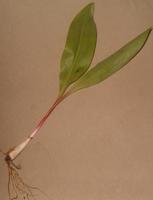 | Back to e-WV
| Back to e-WV
 The West Virginia Encyclopedia
The West Virginia Encyclopedia
 | Back to e-WV
| Back to e-WV
 The West Virginia Encyclopedia
The West Virginia Encyclopedia

Ramps, a member of the lily family and onion genus (Allium tricoccum) and a spring culinary treat, grow from New Brunswick and Minnesota south to Iowa, and in the mountains to North Carolina and Tennessee. In West Virginia, extensive beds of ramps are found in the rich mountain woodlands, particularly in the Monongahela National Forest, which runs along the state’s eastern boundary.
The broad, flat leaves resemble the lily-of-the-valley, and its thin stem and pearly white bulb are reminiscent of the wild onion. Ramps appear in the early spring, but the leaves wither and disappear before flowering time in June and July when delicate white flowers are seen.
This small, highly odoriferous plant was a favorite with early people in the Southern Appalachian mountains, whose winter diet lacked fresh fruit and vegetables. In the very early spring, often when snow still covered the glens, the deep green leaves of the ramp were sought as a welcome addition to the supper table, a taste treat and nutritional supplement. In cooking, the whole ramp, green and bulb, is used. Ramps are typically parboiled and eaten in quantity as a side dish. Many enjoy eating the bulbs raw or substituting the bulbs for onions in recipes.
Many devotees claim ramps possess healing powers, from the prevention of colds, which may be true due to their high content of Vitamin C, to the cleansing of the blood. The ramp’s European cousin, the ramson, recently has been identified as having antibiotic properties. Ramp ‘‘feeds’’ abound in small communities throughout West Virginia in April. The granddaddy of them all, Richwood’s ‘‘Feast of the Ramson,’’ has been held annually since 1938.
Written by Barbara Beury McCallum
McCallum, Barbara B. Mom & Ramps Forever. Charleston: Mountain State Press, 1983.